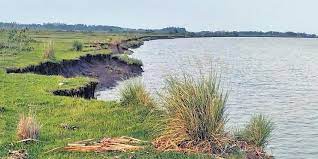Kendrapara: Even though a couple of years have passed since the signing of a memorandum of understanding (MoU) between the Water Resources Department and the National Institute of Ocean Technology (NIOT) aiming at the protection of coastlines and saline embankments in the state, coastal pockets of this district continues to remain prone to floods, cyclonic storms and Tsunamis, according to sources. Sources said the pact was inked by then engineer-in-chief (EIC) Bijay Kumar Mishra and NIOT director GA Ramdas in the presence of former Water Resources minister Tukuni Sahu August 10, 2022. The MoU was aimed at making the coastlines and saline embankments climate-resilient.
However, natural calamities like floods, cyclonic storms and Tsunamis have continued to unleash fear among the residents since the agreement was completed two years ago. The Union Ministry of Environment, Forest and Climate Change sanctions funds to NIOT for strengthening the coastlines and embankments. A rule was also enacted in 1986 for the protection of coastlines and saline embankments in Kendrapara district. A notification has also been issued after the identification of the coastal regulation zone (CRZ). However, coastal districts like Balasore, Bhadrak, Jagatsinghpur, Puri, Ganjam and Kendrapara districts continue to remain vulnerable to natural calamities. The 2015-20 report of the Comptroller and Auditor General (CAG) of India Sanjay Jha, submitted to the President of India, also mentioned the vulnerability of the coastlines and stressed the need for their protection.
The report even expressed displeasure over the increasing natural calamities in the coastal districts of the state. The report said that the devastating impact of natural calamities has failed to die down despite huge expenses. The report also mentioned that industries have come up on the coastlines.
Similarly, prawn gherries have mushroomed and human habitats have also come up on the coastlines. The developments have made the coastline and the environment vulnerable to climate change. Moreover, the State Pollution Control Board (SPCB) was sanctioned over Rs 2.17 crore for the establishment of 19 laboratories between 2013 and 2015 to conduct an environmental study between Paradip in Jagatsinghpur district and Dhamra in Bhadrak district. These laboratories were meant to collect details about the environment in between Paradip and Dhamra. However, the pollution watchdog’s work could not progress beyond 33 to 59 per cent while it is lagging in detecting the air and water quality of the area. The state Forest department claimed that mangrove forests have been created on 228 hectare of land under Rajnagar Mangrove Forest Division and Puri Wildlife Division between 2016 and 2018. However, only 0 to 35 per cent of mangrove plants were found during a survey.
Similarly, the state government has spent around Rs 33 crore and installed a geo-synthetic tube wall on Pentha coast of Puri to protect the coastlines from sea erosion. However, it failed to check coastal erosion due to the onslaught of high tides as the sea waves gnawed away at a large volume of the rocks and stones packed inside the gabion nets. The state government has again spent Rs 4.65 crore on protection of the geo-synthetic tube in 2018 and an additional Rs 3.28 crore after miscreants set it on fire in August, 2019, raising questions over its efficacy in protecting the coastlines from sea erosion. The CAG report also raised various questions on the protection of coastal embankments. Reports said 64 villages have been identified as Tsunami prone while ingress of sea water is taking place in 455 villages during natural calamities like cyclonic storms and floods due to weak coastal embankments.
